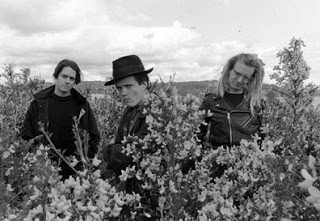
It’s a strange place to feel inspired, you think to yourself, this noisy basement bedroom saturated with stale air and dead acoustics. The year is 1986. The month is a blur.
You’re sitting in the heart of the Seattle home dubbed The Death House, a green-plated monster with a “Churches of Renton Welcome You” sign posted, without explanation, outside. From an adjacent room drifts the unattended drone and buzz of a guitar amp, the barely audible whisper of a needle tracing the infinite loops at the end of a record.
Without fanfare, someone standing near you picks up his Fender-made G&L guitar, plugs it into a twin reverb amp, flicks a switch. The drummer sits, waiting, at his kit as the bassist, his head a mop of blondish hair, grabs a tape player and hits Record.
Pause, 2, 3.
And then it comes.
The music is an organic, shifting and unfolding mass, an incredibly rhythmic pulse of bass and drums that gives way to rivers of crystalline guitar, sparks of inspired noise. It taps into jazz and the locked grooves of dance-floor funk as much as it relies on the driving force and roar of mid-80s punk, the bottom-heavy swagger of heavy metal, the quirkiness of art-rock, the complexity of prog-rock, the unbridled energy of an improvised free-form jam.
This is something that doesn’t belong trapped in basements, you find yourself thinking. This is Vexed.
“I set out to honestly write the most difficult listening music we could,” Milton Garrison, Vexed’s guitarist/vocalist, recently said. “We wanted to challenge the listener. I wanted to threaten the listener’s sensibilities. I didn’t have traditional technique.”
“I wasn’t the slightest bit interested in sounding like anyone else.”

Photo by Jamie Caffery
Vexed formed around 1984 from the ashes of The Altered, In Vitro Pope, and Death of Marat, three groups forged in the eclectic furnace of pre-grunge Seattle. It was an era when the rainy Northwest produced all sorts, varieties, and mutations of independent bands and seemingly no one dropped phrases about any kind of monolithic “scene.” It was a time before Deep Six, before Sub Pop, before “Smells Like Teen Spirit,” before Singles.
With its intoxicating rhythmic patterns, Vexed in its early days arguably owed most of its debts and sonic allegiances to Gang of Four, Chrome, and Killing Joke, local acts like Pell Mell and The Blackouts, and the bizarre Death of Marat, which was the namesake for The Death House and featured C/Z Records label-head Daniel House on bass. But despite the group’s unusually textured and atmospheric sound, core members Garrison and bassist Alfred Butler said Vexed somehow seemed to fit into the bizarre sonic landscape of the D.I.Y. Northwest.
“The Seattle scene in the early 80s was really small (and) everybody knew everybody,” Garrison remembered. “You would get a lot of bills where people would get a reggae band, a funk band, maybe a punk rock band, an industrial disco band, all kind of playing in one show.”
House, now a Northwest ex-pat living in southern California, paints a similar picture.
“Everybody knows Seattle for one thing, right?” he said during a recent phone interview. “But the area (was full) of all these other bands that didn’t fit neatly into that. People don’t realize that. There were a lot of bands that were really distinctive.”
This is the context in which the band formed, an experimental — and loud — rock quartet built around Garrison, Butler, second guitarist Eric Muhs, and drummer Billy Warner. The band’s first recorded appearance came on the Seattle comp Pyrrhic Victory with a track Butler remembers as “Six Foot Hole.” By late 1985/early 1986, the quartet had morphed into a trio, the line-up becoming what many could claim was its most definitive: Garrison, Butler, and drummer David Lapp.
“David kicked ass in an enormous number of ways,” Butler said recently. “He was a fan of the earlier version of the band. When he tried out, he pretty much knew all the songs before we showed them to him. My heart practically leapt out of my throat. I couldn’t believe our good fortune.”
It was clear from square one that Lapp fit perfectly into the Vexed dynamic. At his first live performance with the group — a set opening for the Vancouver band Animal Slaves — the music flowed so effortlessly that the band ended up playing through two encores and for more than an hour, much to the discontent of the main act, Butler remembered.
Aided by Butler’s inventiveness with the bass, Lapp also helped the trio develop one of finest traits: a singular talent at writing enveloping songs around locked grooves and carefully layered rhythmic patterns.
“(That) reminds me of two of my all-time favorite comments about the band,” Butler said. “One chap said we were the ‘most danceable band in Seattle,’ which was for me a major ego-stroke of the highest order. Another said we were the ‘most challenging band to dance to.’ Both comments came after the same gig! But then, I could never dance to most of the kind of stuff that shows up under the label of ‘dance music.’ A beat that’s just dum-dum-dum-dum bores me (and my hips) to tears.”
|
By 1986 and 1987, the band’s rhythms and repetitions also were beginning to draw a loyal local following.
Vexed started appearing regularly at Seattle haunt The Metropolis, frequently shared bills with friends The Cryptkicker Five and Soundgarden (member Hiro Yamamoto played with Garrison in The Altered), opened for The Violent Femmes, and found a champion in Daniel House. On his C/Z Records — a label that released work by everyone from Nirvana, Melvins, Built to Spill, and Skin Yard to Seven Year Bitch, Alcohol Funnycar, Treepeople, and The Gits — House first released the Maybe 7-inch EP, culled from sporadic forays into the studio.
By the time Vexed released a full-length, The Good Fight, the trio had disintegrated, falling into a loosely defined period of inactivity after Lapp left for a job outside Seattle.
The record, later reissued on CD with additional tracks, is a frighteningly good and original one, unlike much of what was pouring onto vinyl from the Northwest at the time. The music on the release seemed bizarrely free-flowing and unscripted, an observation Garrison and Butler said could be both supported and opposed based on the group’s songwriting process.
“Nearly every rehearsal started with a jam,” Garrison said. “These jams could be as long as 40 minutes but usually they were far shorter. These jams were allowed to go wherever they wanted. Basically, they were stream-of-consciousness rambles. If Alfred or others heard something they liked they would nod emphatically, meaning, ‘Continue along these lines because it’s working.’ Or (there was) an equally emphatic shake of the head if the jam lapsed into unresolvable tangents. The jams could also be thought of as warm-ups, like the way an athlete stretches before a game. Or, better put, (it was) a ‘free write,’ like a poet uses to get the muse going.”
Those basement rehearsals, Butler said, were frequently committed to tape and later written and rewritten, a way of taking complex but organic sounds and molding them into complex but organic sounds.
“We’d scour a jam for bits that sounded good together and put them together building-block style,” Butler said. “I’d guess a lot of our style came from my being horribly indecisive. I’d really like how riff A went into riff B, and how riff C went into riff B, and how riff D went into A and B, and we’d end up with an arrangement that was something like ABCBCDADB. And then maybe (we’d) tack on a coda where we reprised a couple of the earlier riffs in different time signatures. I mean, if you’re going to be indecisive, why stick with one meter?”

L to R: Butler, Garrison, Lapp | Photo by Carl Juarez
The band also was nothing if nothing adventurous.
On “The Good Fight,” Garrison ran a school-issue turntable through his guitar and, elsewhere, use his fist to force the strings into the guitar pick-up, creating what he called a “grating-plonk” sound.
Butler was similarly ambitious and curious when it came to sonic control. On “Dirt,” he’d lean his bass headstock against the instrument’s cabinet to drum up feedback. On “Simple Cocks,” which is all chords, he’d create drones on one or more open strings while plucking out a melody on the rest of them. He’d drop-tune, hit all four bass strings with the flat of his hand, experiment with pitch-shifters, and even yell into his bass pickup.
This was hardly a Marshall stack and a couple of disjointed power chords. For all the touchstones of the period on The Good Fight (read: reverb on the drums), the record’s six songs still resonate nearly 20 years later, a rhythm-fused jazz-rock tableau that clearly set the stage for instrumental post-rockers like Ui, Zappa descendents like Tortoise, and even darker prog-rock enthusiasts like Tool.
It was music that also resonated in Seattle, at least until the somewhat-manufactured (or, at least, media-guided) grunge “invasion.” Just ask Jack Endino, studio guru, Skin Yard guitarist, and key member of the aforementioned Cryptkicker Five.
“Forgotten these days is that there was strong thread of early-80s-post-punk-new-wave-art-rock (think Wire, Joy Division, Gang of Four, Killing Joke, UK-dance-rock-with-noisy-guitars, etc.) in the Seattle music scene, which petered out and was crushed by the grunge phenom,” Endino wrote in a recent e-mail. “Vexed morphed into full-on art-funk with a big Killing Joke fix, which, while fully realized in the band, became a musical dead-end here in Seattle as grunge came out, and, well, we know what happened next.”
This theme � music serving as a means to distance a group from a musical scene � was not unfamiliar to the band itself, something Butler said could be seen in lyrics to “Gang of Youth,” one of Vexed’s finest and most biting songs.
|
“Whatever happened to the last 10 years?” Garrison uncharacteristically shrieks after a pensive (and incredibly catchy) introduction crashes to a pounding halt on “Gang of Youth.” “Everything we used to hate has grown so dear / I’m sick to death of my so-called peers.”
“I’m tired of the same thing over and over again / I’m tired of the same thing over and over,” he continues to bark, repeating the phrase in an uncontrolled roar enough times to really pound the venom below the surface of the skin. “I don’t like it now and I didn’t like it then / But what do you do when it happens to your friends?”
Butler, for one, said there’s nothing vague about the lyric’s origins.
“‘Gang of Youth’ is about the Seattle scene,” he said. “It’s about punk-rock turning into just plain rock. It’s about being disgusted when you realize the point wasn’t trying to do anything new, but just biding your time until you were good enough to ape the old. It’s about feeling duped, that the point wasn’t questioning authority, but just about biding your time until you were good enough to play guitar like all the rock guitar Gods you used to mock. It’s about feeling betrayed by your community. It’s about realizing that you were deluded, that you never had a community at all.”
“I remember going to catch Soundgarden at the Vogue one night,” Butler continued, further illustrating his point. “And after a while I began to notice something deeply disturbing: the slower they played, the less I moved, naturally, but the more the crowd moved. And the faster they played the more I moved, naturally, and the less the crowd moved. I felt like I was in a room full of pod people. Thank God I was standing in the back, so they didn’t notice that I wasn’t one of them.”
Garrison is less pointed about perceptions of the band’s place (or the place of its music) in a Seattle changing its focus or face, describing it more as a sense of style than scene.
“We didn’t really get grunge and I think … we couldn’t figure out why these other bands were getting all this attention,” said Garrison, in a phone interview late last year. “The way we saw it was, ‘Okay, there’s already been an Iggy and The Stooges and there’s already been a Led Zeppelin. What the hell?!'”
“What’s wrong with doing something a little different, that’s never been done before?”

Vexed C/Z promo photo circa Cathexis | Photo by Susan Crocker
Vexed re-formed, for lack of a better word, around 1992, the year after punk “broke” and just a handful of months after a little rock trio from Aberdeen, Washington known as Nirvana hit the pop chart’s coveted top spot.
Things, right from the start, were different. While the most notable change may have been the replacement of Lapp with the more rock-oriented drummer Buzz Crocker, also of Alcohol Funnycar, the band’s material had grown more direct and darker.
The liner notes of Cathexis, an eight-song full-length released by C/Z around 1994, seem to hint at this, informally subtitling track listings with phrases like “There is revolutionary inspiration in dark surrealism” and “This goes out to anyone who has felt cursed by self-awareness.”
What’s scribbled underneath the title of the record’s last song, a morose12-minute death march called “Dirt” that’s fixated on a mind-boggling Minimalist guitar loop? “The horror … the horror.”
Indeed.
“We knew what worked for us musically, and we made an attempt to improve on those strengths that we’d developed during the Lapp years,” Garrison said. “Although I seem to remember making a personal decision to make Vexed more rock-oriented, I don’t know how true that impression can be. Because when I listen to what we were moving toward, I think it was, ironic or not, less commercial than previous work.”
The intoxicating loops were still imbedded in Vexed’s later work, but they were supplemented by hooks, too, choruses and occasionally grimy verses that may have sounded more rooted in late 80s/early 90s Seattle. Some personal/emotional stresses also added to the darker tone of the record, Butler said.
But by the time the record hit the streets, the trio again had split. What became the group’s final demo, appropriately recorded at The Death House in 1994, remains unreleased.

Photo by Susan Crocker
In hindsight, it all sort of made sense.
The trio never came together with Crocker on drums the way it did when Lapp was behind the kit. And following up The Good Fight was a tall order. But why hasn’t Vexed’s legacy — a couple of full-lengths, some scattered recordings, and a reputation for energetic live performances — survived?
Why wasn’t the band name-dropped in the surprisingly well-done documentary Hype? Why hasn’t Vexed’s name been preserved in the collective memory the same way others’ have?
One of the problems with being Vexed is it’s hard to market you, Garrison said recently. Endino said other things also play into that.
“Vexed played some of the best shows I ever saw from a Seattle band, but the grunge crowd kept their distance. Their loss,” he said. “Remember, history is written by the victors, so Seattle music history is now 100 percent grunge-centric. The ‘other’ bands we’re speaking of here didn’t ‘do’ much to leave a mark. No national tours, no big record deals.”
“Afterwards, the grunge thing, though not yet called that by name until ’89 or so, sort of separated itself out,” he added. “There were the ‘hip’ Sub Pop bands and then there was everyone else, which was still a lot of great bands. Eventually, the ‘everyone else’ became sort of an anti-scene, a self-conscious ‘Oh well, guess we’re not a grunge band, but who cares’ thing. But you had bands as diverse as the Young Fresh Fellows, Coffin Break, Gas Huffer, The Gits, heck, a million other great bands who existed. But for a few years, ‘everyone else’ was overshadowed by the Sub Pop hype juggernaut, to the extent that Sub Pop and ‘grunge’ simply became synonymous with ‘Seattle’ to most people who didn’t live here. This actually got pretty annoying to the rather large ‘everyone else’ crowd, as you can imagine… So there you have the situation with Vexed: two albums, no national touring, no hype. Could apply to any of a zillion bands.”

Vexed records L to R: The Good Fight, Maybe EP, Cathexis
But those albums survive, something that still stirs excitement in the man who helped preserve them to vinyl: Daniel House.
“There was just a lot of interesting music happening at the time, and I didn’t want to be as limited creatively as Sub Pop was,” said House, a former Sub Pop employee who ran C/Z for the better part of two decades. “I wanted to be broader than that. I wanted to put out music that was good. That’s it.”
 And Vexed, from the sounds of it, just wanted to make music that was what they heard in their heads, regardless of whether Charles Peterson was in the audience reading to capture them in blurred, lunging action on grainy black-and-white film.
And Vexed, from the sounds of it, just wanted to make music that was what they heard in their heads, regardless of whether Charles Peterson was in the audience reading to capture them in blurred, lunging action on grainy black-and-white film.
“I remember the impression of some people might have been that Vexed was overly arty and pretentious,” Garrison said. “One of us said, ‘Most bands pretend unpretentiousness.’ I think that’s true of bands in general.”
“I liked to say, ‘This is what we do,'” he added.
“‘We open our mouths and Vexed is what comes out.'” – Delusions of Adequacy, July 24, 2005






